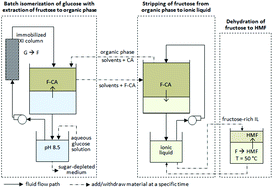High yield 5-(hydroxymethyl)furfural production from biomass sugars under facile reaction conditions: a hybrid enzyme- and chemo-catalytic technology
Abstract
An integrated process for high-yield production of 5-(hydroxymethyl)furfural (HMF) from glucose in biomass hydrolysates has been described. Previous attempts to generate HMF in aqueous media (either from untreated biomass or from hydrolysates) have not resulted in high yields due to loss of product to humins and inability to prevent hydrolysis of HMF to levulinic and formic acids. Further, it is now broadly recognized that the best yields of HMF can be obtained by dehydration of the ketose-isomers (fructose), rather than the aldose sugar, and by executing the reactions in non-aqueous reaction media (e.g. DMSO and Ionic Liquids (ILs)). The challenge then, for cost-effective HMF production, is to devise a cohesive pathway to efficiently isomerize glucose in a biomass hydrolysate, transfer the fructose into suitable non-aqueous reaction media, produce the HMF in a high yield, and recover the product – all with low energy input and recycling of process streams. This paper addresses these challenges through a hybrid enzyme- and chemo-catalytic process. The conversion of hydrolysate glucose to fructose and near-complete recovery of the ketose are accomplished through a novel enzyme-based Simultaneous-Isomerization-and-Reactive-Extraction (SIRE) process. In SIRE, hydrolysate sugars are isomerized using immobilized glucose isomerase enzyme and reactively-extracted into a water-immiscible organic phase (octanol) through the use of a ketose-selective binding agent (lipophilic aryl boronic acid). The sugars are recovered from the organic phase by Back-Extraction (BE) into an acidic IL (1-ethyl-3-methylimidazolium hydrogen sulfate ([EMIM]HSO4)) reaction medium. The ketose sugar is dehydrated to HMF with high reaction yields (>80%) in [EMIM]HSO4 even under mild reaction conditions (50 °C, ambient pressure). Since the isomerization-enzyme, the ketose-selective binding agent, and the dehydration catalysts are phase-confined, this method permits prolonged reuse of the catalysts, solvents and reaction media. This technology has been demonstrated with a corn-stover hydrolysate produced via dilute-acid pretreatment.


 Please wait while we load your content...
Please wait while we load your content...